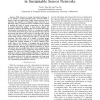Free Online Productivity Tools
i2Speak
i2Symbol
i2OCR
iTex2Img
iWeb2Print
iWeb2Shot
i2Type
iPdf2Split
iPdf2Merge
i2Bopomofo
i2Arabic
i2Style
i2Image
i2PDF
iLatex2Rtf
Sci2ools
106
click to vote
ICNP
2009
IEEE
2009
IEEE
ESC: Energy Synchronized Communication in Sustainable Sensor Networks
—With advances in energy harvesting techniques, it is now feasible to build sustainable sensor networks (SSN) to support long-term applications. Unlike battery-powered sensor networks, the objective of sustainable sensor networks is to effectively utilize a continuous stream of ambient energy. Instead of pushing the limits of energy conservation, we are aiming at energy-synchronized designs1 to keep energy supplies and demands in balance. Specifically, this work presents the Energy Synchronized Communication (ESC) as a transparent middleware between the network layer and data link layer that controls the amount and timing of RF activity at receiving nodes. In this work, we first derive a delay model for cross-traffic at individual nodes, which reveals an interesting stair effect in low-duty-cycle networks. This effect allows us to design a localized energy synchronization control with O(1) time complexity that shuffles or adjusts the working schedule of a node to optimize crosstr...
Energy Harvesting Techniques | Energy Synchronized Communication | ICNP 2009 | Network Protocols | Sustainable Sensor Networks |
Related Content
| Added | 23 May 2010 |
| Updated | 23 May 2010 |
| Type | Conference |
| Year | 2009 |
| Where | ICNP |
| Authors | Yu Gu, Ting Zhu, Tian He |
Comments (0)

